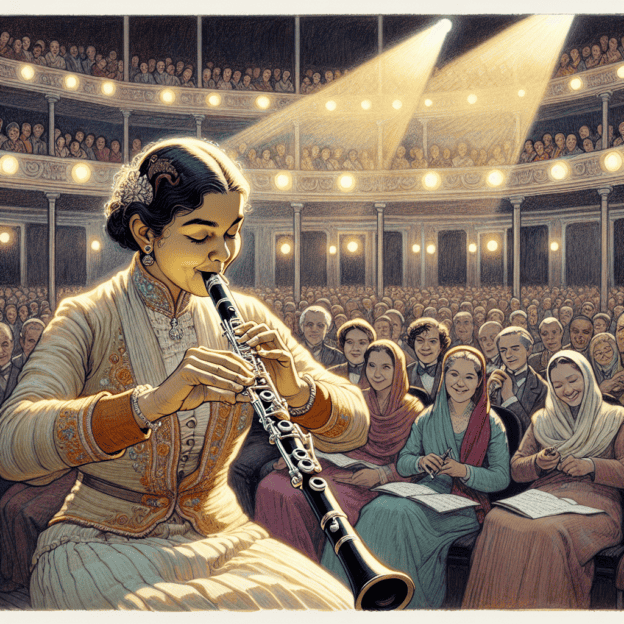The Art of Classical Clarinet Interpretation
When you think about classical music, names like Mozart and Brahms pop up, right? But let's take a moment to shine a light on the amazing clarinet players who bring these masterpieces to life through their unique interpretations. From their technique to their approach, each player really adds their special touch. It's like putting icing on a cake—the cake being the beautiful music itself! In this post, we'll explore how classical clarinet players interpret pieces, giving you insights and tips along the way.
Sabine Meyer: Precision and Emotion Combined
First off, let's consider the phenomenal clarinetist Sabine Meyer. She's not just a performer; she's a sensation! Known for her work in symphonic orchestras and chamber music, Meyer's interpretations are something you just can't overlook. She brings an emotional depth to the music, accessing the soul of each piece. Her style often combines precision with a lyrical flow that's simply mesmerizing. It's fascinating how she connects with the audience, making you feel every note.
Benny Goodman: The King of Swing Meets Classical
Now, we can't talk about clarinetists without mentioning the legendary Benny Goodman. Often referred to as the ‘King of Swing', Goodman revolutionized not just jazz, but also how the clarinet could be perceived in classical settings as he blended genres like a pro! What sets his playing apart is his impeccable timing and ability to swing. He can make you tap your feet with just a few notes. The next time you listen to his recordings, take a moment to think about how, even within the classical framework, he infused swing elements without losing the integrity of the piece.
| Clarinetist | Notable Style | Key Contribution |
|---|---|---|
| Sabine Meyer | Precision with lyrical flow | Emotional depth in symphonic and chamber music |
| Benny Goodman | Swing elements in classical music | Bridging jazz and classical genres |
| Martin Fröst | Innovative and daring | Expanding clarinet repertoire |
| Eric Dolphy | Avant-garde and experimental | Influencing contemporary clarinetists |
Martin Fröst: Pushing Boundaries
Moving on, let's give a nod to Martin Fröst. An innovative clarinetist, he has breathed new life into the classical clarinet repertoire with his exquisite style and bold interpretations. Fröst has a talent for choosing diverse pieces that aren't typically associated with clarinet performance. From contemporary works to collaborations with popular artists, he shows how the clarinet can be a versatile and modern instrument while still respecting its classical roots. His take on classics often leaves the audience surprised and delighted, showcasing that music truly has no limits!
Eric Dolphy: Jazz Meets Classical
Ah! And speaking of versatility, have you heard of Eric Dolphy? He stepped outside traditional classical interpretations and embraced avant-garde sounds. The way he combines jazz and classical has influenced many contemporary clarinetists. It's worth noting how innovation can exist alongside classical interpretations, creating hybrid styles that keep the music fresh and exciting. His exploratory approach in performances has paved the way for other clarinetists to experiment and take risks.
The Importance of Quality Instruments
So, what makes these players stand out? Aside from their technique and emotional expression, let's chat about the instruments they choose. Having a top-notch clarinet is incredibly important. Instruments like those crafted by Martin Freres are celebrated for their exceptional craftsmanship and sound quality. Musicians understand that the key to delivering a powerful and engaging performance often lies in the tools they use. Quality instruments enhance the player's ability to control nuances in sound—certainly something we've seen with Meyer, Goodman, and Fröst.
Style and Interpretation
Now, have you ever thought about how style influences interpretation? You could have two clarinetists playing the same concerto, and yet, they'll sound entirely different! This really speaks to the beauty of classical music—the interpretation allows artists to add their personal flair. Techniques such as vibrato, dynamics, and articulation can dramatically shift the mood. For instance, a swift, crisp vibrato can give an exhilarating feel, while a slow, rich vibrato draws listeners into a heartfelt moment. Each player has their secret ingredients for cooking up sounds that capture their audience.
Phrasing and Articulation
While many elements contribute to a clarinetist's interpretation style, listen closely to how they phrase their notes. Some players will tie their notes together, creating a smooth, connected line, while others might choose sharp articulations that create a bouncing effect. The artistry lies in how they decide to express each movement's intent while still adhering to the essence of the composition.
Historical Context in Interpretation
It's also amazing to see how historical context plays a role in interpretation. Take, for example, pieces from the Romantic era, which often call for emotional expressiveness. Clarinetists will go into detail about dynamics, using subtle changes in volume meander through phrases. It's almost like we get a glimpse into the period's emotional landscape through their performance.
Advice for Aspiring Clarinetists
For budding clarinetists, consider attending concerts, masterclasses, or workshops. Seeing professionals interpret music can significantly influence your own approach. Ask questions, learn styles, and most importantly, practice! Discover what elements resonate most with you and experiment with them in your playing. Remember, your interpretation is ultimately about how you connect with the music.
Practice Tips
What about taking these lessons to heart? Try recording yourself—there's nothing quite like listening back to hear where you shine. Assess your style, experiment with different interpretations, and don't be afraid to put your flair on pieces you love. Maybe one day, you'll be on stage captivating audiences just like Meyer, Goodman, and Fröst!
Conclusion
To wrap up, classical clarinet players' interpretations breathe life into each piece. Their individual styles and preferences combined with the use of quality instruments, such as those from Martin Freres, set them apart. This journey through different interpretations encourages aspiring musicians to explore their paths. Jump into the world of clarinet playing and discover your unique sound!
Table of Contents
- The Art of Classical Clarinet Interpretation
- Sabine Meyer: Precision and Emotion Combined
- Benny Goodman: The King of Swing Meets Classical
- Martin Fröst: Pushing Boundaries
- Eric Dolphy: Jazz Meets Classical
- The Importance of Quality Instruments
- Style and Interpretation
- Phrasing and Articulation
- Historical Context in Interpretation
- Advice for Aspiring Clarinetists
- Practice Tips
- Conclusion







